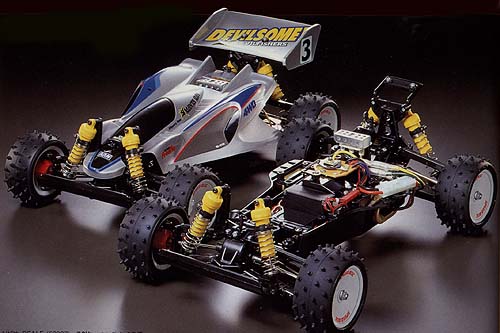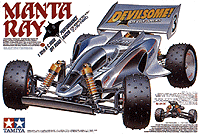Analysis of individual cars
The Manta Ray (58087)

The Manta Ray was kit number 87 from Tamiya. A 1/10 4WD off-road buggy, it was designed to appeal to beginners and experts alike.
Specifications
- 1/10 scale off-road vehicle
- 4 wheel drive (shaft driven)
- Plastic tub-chassis design
- Independent double wishbone system with dog bone drive axles
- Four coil spring over oil damped shocks
- RS-540 Mabuchi motor
- Pin spike off-road tires with aero dish wheels
- Lexan body
Description
The Manta Ray came out as a replacement for the aging Thundershot chassis and gear box design. As with all Tamiya models, this was an evolution of a design as opposed to a new re-design. The gearboxes were modified to be even more compact than before. This allowed for a better center of gravity and longer suspension arms. Drive cups and dog bones were retained from the older designs but the lower suspension arm has been made stronger by molding them from solid plastic as opposed to the frame design of the Thundershot.
Steering system was further improved for less bump steer and chassis was redesigned for greater rigidity. If you look inside the tub on a Manta Ray, you'll see hexagonal webbing molded into the bottom to further increase rigidity. Fully independent suspension was improved with long travel shocks in the rear for smoother transitions over bumpy surfaces.
The single upper arms allowed for hop ups with adjustable turnbuckle sets. This was a nice because the stock setup tended to severely understeer.
Topping this is another great lexan body from Tamiya. If you ever take the time to study Tamiya lexan bodies you’ll know why they are the leaders in the field. The short is that they have far greater detail and realism than any other bodies available on the market. The reasoning for it is far more in-depth. Tamiya has the most advanced equipment and experience for making lexan bodies. Compound curves and sharp edges that other manufacturers avoid, Tamiya jumps into. If you compare a Tamiya body against any other you’ll see that the Tamiya body has been molded with a lot more surface detail where other manufacturers tend to have lexan bodies that come off as being nothing more than "blobs".
By the time the Manta Ray was introduced, the R/C car market was already in a slump. Unlike the mid-eighties when anything and everything on wheels sold, the early 90’s was a different situation altogether. Sales were slumping in off-road buggies and a lot of small manufacturers went the way of the Dodo bird. Even Tamiya concentrated more on on-road vehicles and would later introduce a breakthrough touring car based on this chassis. In fact, the much sought after ball-differential hop-up for the Manta Ray was probably rarely ever purchased for the Manta Ray, rather they were used mostly in the Nissan Skyline touring car that was hot at the time.
Historical Significance
 The Manta Ray marks the debut of a new chassis and drivetrain design from Tamiya, but it is a bit too new to really enjoy a collector’s market. Right now collectors are grabbing new in box versions and not much else. Used Manta Ray’s are going for typical used R/C prices.
The Manta Ray marks the debut of a new chassis and drivetrain design from Tamiya, but it is a bit too new to really enjoy a collector’s market. Right now collectors are grabbing new in box versions and not much else. Used Manta Ray’s are going for typical used R/C prices.
Having said that though, you won’t find a lot of used Manta Rays available. They didn’t sell that well when new. You’re actually more likely to find a NIB Manta Ray sitting on some hobby store shelf.
History will probably show that the Manta Ray will be collected less as an off-road buggy, but more as the beginnings of the touring car craze in North America. You see, Tamiya used the chassis from this buggy to create the TA-01 which sparked the new touring car trend that dominated the late 90's and early '00. In fact, the chassis went on to launch three separate touring car chassis; the TA-01, TA-02 and FF. All of which can find bits and pieces of their bloodline in the Manta Ray.
Additional Notes
Even though it was an off-road car, like most Tamiya cars of this era, they were somewhere fragile. Tamiya did make efforts to mold the cars out of a more flexible plastic than before. But the greatly reduced front bumper now didn’t protect the front suspension during an off-center or side angle collision. Especially weak were the steering knuckles, an adaptation of the ones used in the original Hotshot, they’re no stronger now than they were before.
Rear shock towers also took some abuse whenever the car was involved in a rollover. Look for completeness and condition of a used car when purchasing.
Rating
- Collectibility – 5 out of 10
- Fun to drive – 7 out of 10
- Parts availability – 6 out of 10
